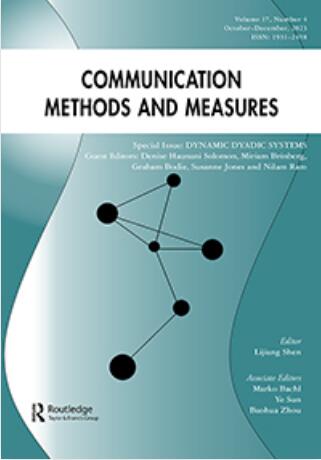Latent Semantic Scaling: A Semisupervised Text Analysis Technique for New Domains and Languages
IF 3.7
1区 文学
Q1 COMMUNICATION
引用次数: 48
Abstract
ABSTRACT Many social scientists recognize that quantitative text analysis is a useful research methodology, but its application is still concentrated in documents written in European languages, especially English, and few sub-fields of political science, such as comparative politics and legislative studies. This seems to be due to the absence of flexible and cost-efficient methods that can be used to analyze documents in different domains and languages. Aiming to solve this problem, this paper proposes a semisupervised document scaling technique, called Latent Semantic Scaling (LSS), which can locate documents on various pre-defined dimensions. LSS achieves this by combining user-provided seed words and latent semantic analysis (word embedding). The article demonstrates its flexibility and efficiency in large-scale sentiment analysis of New York Times articles on the economy and Asahi Shimbun articles on politics. These examples show that LSS can produce results comparable to that of the Lexicoder Sentiment Dictionary (LSD) in both English and Japanese with only small sets of sentiment seed words. A new heuristic method that assists LSS users to choose a near-optimal number of singular values to obtain word vectors that best capture differences between documents on target dimensions is also presented.潜在语义缩放:一种新领域和语言的半监督文本分析技术
摘要许多社会科学家认识到定量文本分析是一种有用的研究方法,但它的应用仍然集中在用欧洲语言撰写的文件中,尤其是英语,以及政治学的少数子领域,如比较政治和立法研究。这似乎是由于缺乏灵活且经济高效的方法来分析不同领域和语言的文档。为了解决这个问题,本文提出了一种半监督的文档缩放技术,称为潜在语义缩放(LSS),它可以在各种预定义的维度上定位文档。LSS通过结合用户提供的种子词和潜在语义分析(词嵌入)来实现这一点。这篇文章在《纽约时报》关于经济的文章和《朝日新闻》关于政治的文章的大规模情绪分析中展示了它的灵活性和效率。这些例子表明,在英语和日语中,LSS只需少量的情感种子词就可以产生与词典情感词典(LSD)相当的结果。还提出了一种新的启发式方法,该方法帮助LSS用户选择接近最优数量的奇异值,以获得最能捕捉目标维度上文档之间差异的词向量。
本文章由计算机程序翻译,如有差异,请以英文原文为准。
求助全文
约1分钟内获得全文
求助全文
来源期刊

Communication Methods and Measures
COMMUNICATION-
CiteScore
21.10
自引率
1.80%
发文量
9
期刊介绍:
Communication Methods and Measures aims to achieve several goals in the field of communication research. Firstly, it aims to bring attention to and showcase developments in both qualitative and quantitative research methodologies to communication scholars. This journal serves as a platform for researchers across the field to discuss and disseminate methodological tools and approaches.
Additionally, Communication Methods and Measures seeks to improve research design and analysis practices by offering suggestions for improvement. It aims to introduce new methods of measurement that are valuable to communication scientists or enhance existing methods. The journal encourages submissions that focus on methods for enhancing research design and theory testing, employing both quantitative and qualitative approaches.
Furthermore, the journal is open to articles devoted to exploring the epistemological aspects relevant to communication research methodologies. It welcomes well-written manuscripts that demonstrate the use of methods and articles that highlight the advantages of lesser-known or newer methods over those traditionally used in communication.
In summary, Communication Methods and Measures strives to advance the field of communication research by showcasing and discussing innovative methodologies, improving research practices, and introducing new measurement methods.
 求助内容:
求助内容: 应助结果提醒方式:
应助结果提醒方式:


